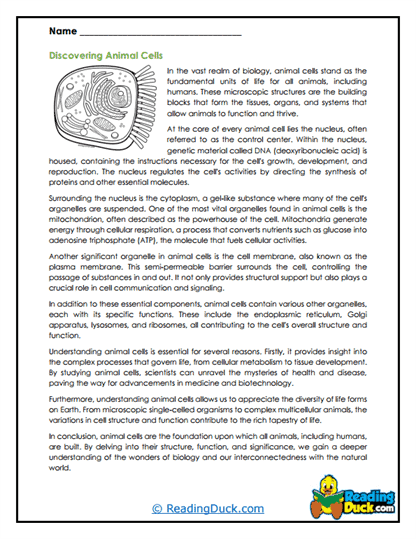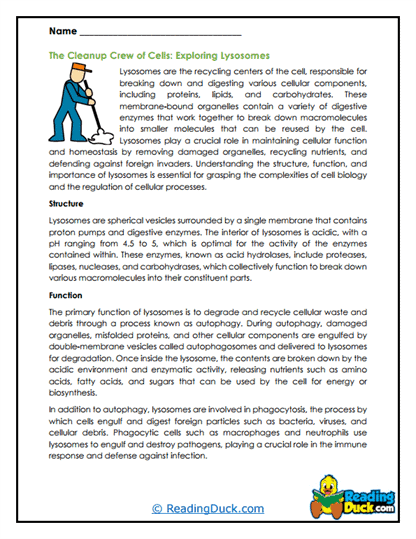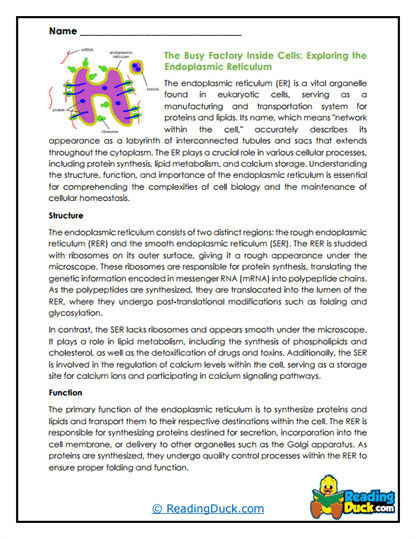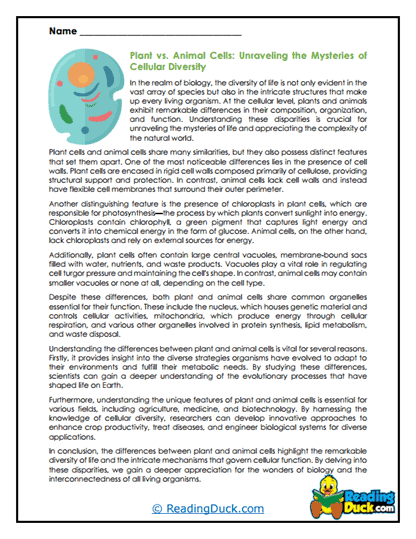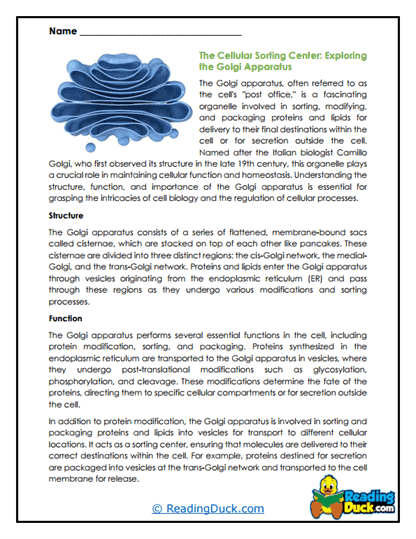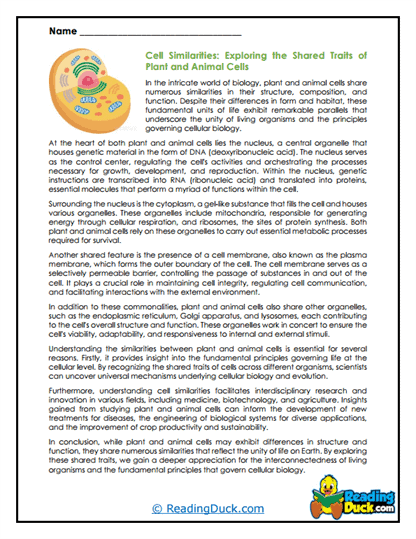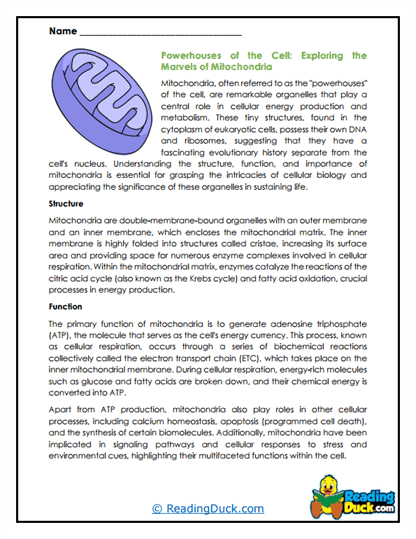Cell Biology Worksheets
About Our Cell Biology Worksheets
Our collection of Cell Biology worksheets is designed to provide students with a solid understanding of the fundamental unit of life: the cell. As a subtopic under Biology, these worksheets delve into the structure, function, and significance of cells, offering an engaging way to explore the microscopic world that forms the basis of all living organisms. Each worksheet set is crafted to reinforce key concepts through a variety of question formats and visual aids.
Each worksheet set includes:
- Multiple Choice Questions: These questions assess students' understanding of the reading passage by offering multiple answer choices, helping to reinforce essential facts and concepts about cell biology.
- Short Answer Questions: In this section, students are encouraged to write their own answers to questions based on the reading passage. This format promotes a deeper understanding by allowing students to express what they have learned in their own words.
- Open-Ended Questions: These questions prompt students to provide personal input, opinions, or reflections related to the reading material. This format encourages students to connect the topic of cell biology to their own experiences and broader understanding of life sciences.
Each worksheet also comes with an answer key, making it easy for teachers and parents to review and assess students' work. All worksheets are available as PDF files, which can be easily viewed electronically, downloaded, and printed for use in classrooms or homeschool settings.
Understanding Cells: The Building Blocks of Life
Cells are the basic building blocks of all living organisms, from the tiniest bacteria to the largest mammals. When teaching students about cell biology, it's essential to start with the concept that every living thing is made up of cells. These tiny units carry out the processes necessary for life, and understanding them is fundamental to grasping the broader concepts of biology.
What Are Cells?
Cells are the smallest unit of life that can function independently. They are often referred to as the "building blocks" of life because they are the basic structural and functional units of all living organisms. Cells come in two main types: prokaryotic and eukaryotic, each with distinct characteristics and functions.
Types of Cells
- Prokaryotic Cells:
- Definition: Prokaryotic cells are simpler and smaller than eukaryotic cells. They do not have a nucleus or other membrane-bound organelles. Instead, their genetic material is found in a single, circular DNA strand that floats freely in the cell.
- Examples:
- Bacteria: Bacteria are the most common type of prokaryotic cells. They play crucial roles in ecosystems, including decomposing organic material and fixing nitrogen in the soil.
- Archaea: Archaea are another group of prokaryotic organisms that are often found in extreme environments, such as hot springs and salt lakes.
- Eukaryotic Cells:
- Definition: Eukaryotic cells are more complex and larger than prokaryotic cells. They have a nucleus that houses their genetic material, as well as various membrane-bound organelles that perform specific functions within the cell.
- Examples:
- Plant Cells: Plant cells are eukaryotic cells that have a rigid cell wall, chloroplasts for photosynthesis, and a large central vacuole for storing nutrients and waste products.
- Animal Cells: Animal cells are also eukaryotic, but they lack a cell wall and chloroplasts. They have various organelles, such as mitochondria, which are the powerhouses of the cell, providing energy for all cellular activities.
Key Components of Cells
Understanding the different parts of a cell helps students grasp how these tiny units function as the building blocks of life. Here are the main components found in eukaryotic cells:
- Nucleus:
- Function: The nucleus is the control center of the cell, containing the cell's DNA, which holds the genetic blueprint for all cellular activities. The nucleus directs the production of proteins and cell division.
- Cell Membrane:
- Function: The cell membrane is a protective barrier that surrounds the cell, controlling what enters and exits. It is selectively permeable, allowing only certain substances to pass through, thereby maintaining the cell's internal environment.
- Cytoplasm:
- Function: The cytoplasm is a jelly-like substance that fills the cell, providing a medium in which the organelles can function. It also plays a role in cellular processes, such as glycolysis and signal transduction.
- Mitochondria:
- Function: Mitochondria are known as the "powerhouses" of the cell. They convert energy from nutrients into adenosine triphosphate (ATP), which the cell uses to power various functions.
- Ribosomes:
- Function: Ribosomes are responsible for protein synthesis. They translate genetic information from the nucleus into proteins that perform various functions within the cell.
- Endoplasmic Reticulum (ER):
- Function: The ER is a network of membranes involved in protein and lipid synthesis. The rough ER has ribosomes attached to its surface and is involved in protein synthesis, while the smooth ER is involved in lipid production and detoxification processes.
- Golgi Apparatus:
- Function: The Golgi apparatus modifies, sorts, and packages proteins and lipids for storage or transport out of the cell.
- Chloroplasts (in Plant Cells):
- Function: Chloroplasts are the site of photosynthesis in plant cells. They capture sunlight and convert it into chemical energy, which the plant uses to grow and produce food.
The Role of Cells in Organisms
Cells do not exist in isolation; they work together to form tissues, organs, and systems in multicellular organisms. Understanding this hierarchy is essential for grasping how complex organisms, including humans, function:
- Tissues: Groups of similar cells that perform a specific function. For example, muscle tissue is made up of muscle cells that contract to produce movement.
- Organs: Structures composed of different types of tissues working together to perform a specific function. The heart, for example, is an organ made of muscle tissue, nervous tissue, and connective tissue, all working together to pump blood.
- Organ Systems: Groups of organs that work together to perform complex functions necessary for the survival of an organism. The digestive system, for example, includes the stomach, intestines, and other organs that work together to digest food and absorb nutrients.
Ideas For Supplementary Activities
To enhance the learning experience, teachers and parents can use these Cell Biology worksheets in creative and effective ways:
- Microscope Lab Activity - Allow students to observe different types of cells under a microscope, such as onion cells, cheek cells, or plant leaf cells. Encourage them to identify and label the organelles they see, linking the visual observation with the information learned from the worksheets.
- Cell Model Project - Have students create 3D models of plant and animal cells using materials like clay, gelatin, or recycled items. This hands-on activity helps students visualize and understand the structure and function of different cell organelles.
- Interactive Cell Diagram - Provide students with an interactive cell diagram where they can label each part of the cell and describe its function. This can be done digitally or on paper and helps reinforce their knowledge of cell anatomy.
- Cell Division Animation - Use an animation tool or software to create a simple animation that demonstrates the process of mitosis or meiosis. Students can create their own or analyze an existing animation to better understand the steps and significance of cell division.
- Comparative Essay - Assign students a short essay comparing prokaryotic and eukaryotic cells. Encourage them to use the information from the worksheets to discuss the similarities and differences, as well as the evolutionary significance of each cell type.
The Vital Importance of Cell Biology in the Real World
Understanding cell biology is fundamental to grasping how life functions at its most basic level. Cells are the building blocks of all living organisms, and their processes are at the heart of health, growth, and reproduction. Knowledge of cell biology is crucial not only for academic purposes but also for real-world applications, including medicine, genetics, biotechnology, and environmental science. By studying cells, students gain insight into the intricate mechanisms that sustain life, helping them appreciate the complexity and beauty of living organisms and the importance of scientific inquiry in improving human health and preserving the environment.
